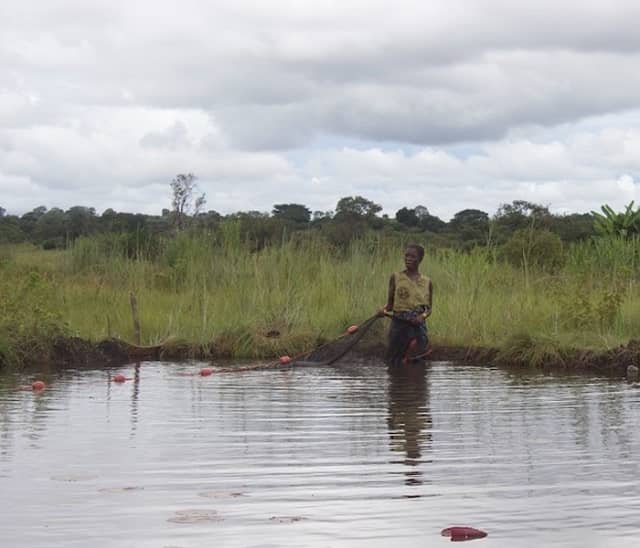
by University of Stirling
Scientists from the University of Stirling’s Institute of Aquaculture and WorldFish have recently published an open-access paper entitled ‘The role of aquaculture and capture fisheries in meeting food and nutrition security: Testing a nutrition-sensitive pond polyculture intervention in rural Zambia’ in the scientific journal, Foods.
The study found that pond polyculture – farming multiple species in one system – can serve as a supplement to capture fisheries that are subject to seasonal restrictions, as well as to tilapia farming. This finding is distinct from other assessments of how aquatic foods can improve food and nutrition security by taking into consideration the consumption of fish from diverse sources by households.
“Polyculture of small and large fish species in homestead ponds improves food and nutrition security of households as well as reduces micronutrient deficiencies, especially in pregnant and lactating women and children in the first 1000 days of life,” explained co-author Shakuntala Haraksingh Thilsted, WorldFish’s Global Lead for Nutrition and Public Health.
“Small fish, consumed whole, including the head, organs and bones, pack a bigger punch in terms of vitamins, minerals and omega-3 fatty acids as compared to the fillet of large fish,” added Thilsted who is also the 2021 World Food Prize Laureate.
Thilsted was the first to examine the nutritional composition of indigenous small fish species, commonly found and consumed in Bangladesh and Cambodia. Her research demonstrated that these affordable and locally available aquatic foods offer life-changing benefits for children’s cognitive development in the early stages of their life and the nutrition and health of their mothers. From this breakthrough, she went on to develop nutrition-sensitive approaches and innovations to food production, distribution and consumption that led her to receive the 2021 World Food Prize.
Bringing a tried-and-tested innovation to Zambia
WorldFish scientists took these lessons to Zambia by working with smallholder homesteads to stock various micronutrient-rich small fish species. Indigenous small fish species are commonly found in wetlands, rivers and streams that farmers use to stock their ponds. Most of the small-scale pond systems in Zambia naturally attract large quantities of indigenous small fish species as they swim in and out of the pond inlets and outlets. This presents an opportunity for fish to be ‘trapped’ or for farmers to actively stock them from the wild if they thrive well in ponds.
However, small-scale farmers in Zambia are often encouraged to cultivate tilapia in monoculture systems, removing indigenous small fish species from their ponds. The authors thus aimed to rethink tilapia pond systems in Zambia as multi-species systems (polyculture) rather than single-species systems (monoculture) that would offer a direct source of food for household consumption rather than farming tilapia strictly for markets.
The authors also identified that aquaculture, especially polyculture systems with indigenous small fish species, has the potential to improve the nutrient intake of households during closed fishing seasons. Fisheries management regulations, introduced by the Zambian government to overcome overfishing, ban the capture or sale of wild fish between December and February every year. However, these measures drastically reduce the consumption of fish during these months, leading to lower intakes of key nutrients and essential fatty acids. This is especially pertinent for people living in parts of Zambia where fish is their primary source of animal protein.
Stay Always Informed
Join our communities to instantly receive the most important news, reports, and analysis from the aquaculture industry.
“While ponds provide an important supply of fish – polyculture ponds provide a good source of diverse, micronutrient-rich small fish species – however, the amount of fish from the wild, especially small fish species from the large lakes that are dried, play a more significant role in people’s nutrient intake,” said lead author Alexander Kaminski.
“Ultimately, any improvements to aquaculture should not be done in isolation without considering the more important role of capture fisheries in providing cheap, micronutrient-rich small fish for vulnerable people,” elaborated Kaminski, a doctoral candidate at the University of Stirling.
The authors urged the conservation of Zambia’s diverse ecosystems, especially where nutrient-rich indigenous small fish species reside to achieve food and nutrition security.
Reference (open access)
Kaminski, Alexander M., David C. Little, Lucinda Middleton, Muleya Syapwaya, Mary Lundeba, Jacob Johnson, Carl Huchzermeyer, and Shakuntala H. Thilsted. 2022. “The Role of Aquaculture and Capture Fisheries in Meeting Food and Nutrition Security: Testing a Nutrition-Sensitive Pond Polyculture Intervention in Rural Zambia” Foods 11, no. 9: 1334. https://doi.org/10.3390/foods11091334
Editor at the digital magazine AquaHoy. He holds a degree in Aquaculture Biology from the National University of Santa (UNS) and a Master’s degree in Science and Innovation Management from the Polytechnic University of Valencia, with postgraduate diplomas in Business Innovation and Innovation Management. He possesses extensive experience in the aquaculture and fisheries sector, having led the Fisheries Innovation Unit of the National Program for Innovation in Fisheries and Aquaculture (PNIPA). He has served as a senior consultant in technology watch, an innovation project formulator and advisor, and a lecturer at UNS. He is a member of the Peruvian College of Biologists and was recognized by the World Aquaculture Society (WAS) in 2016 for his contribution to aquaculture.




